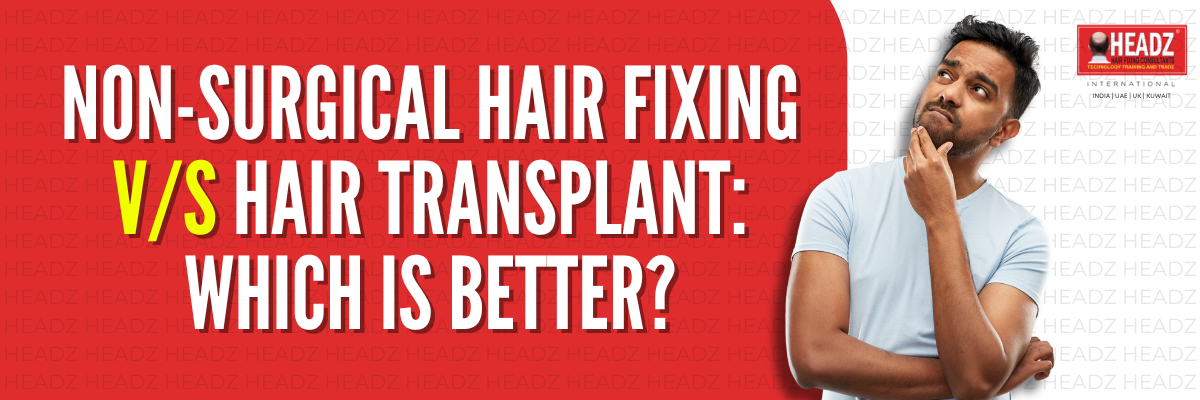Non-Surgical Hair Fixing vs. Hair Transplant: Which Is Better?

- headz
Hair loss is a common challenge faced by millions of people worldwide. With advancements in hair restoration solutions, two popular options stand out—non-surgical hair fixing and hair transplant surgery. But which one is the better solution for you?
In this blog, we’ll explore the pros, cons, and differences between non-surgical hair fixing and hair transplant procedures to help you make an informed decision.
What is Non-Surgical Hair Fixing?
Non-surgical hair fixing is a cosmetic solution that involves attaching a hair patch, wig, or hair system to areas experiencing hair loss. It offers instant results without surgery, pain, or downtime.
Key Features:
- Uses customized hair patches or systems.
- Applied using clips, medical-grade adhesives, or tapes.
- Painless and non-invasive.
- Provides an instant natural-looking appearance.
What is Hair Transplant Surgery?
A hair transplant is a medical procedure where hair follicles are taken from one part of the scalp (usually the back or sides) and implanted in bald or thinning areas.
Key Features:
- Involves surgical extraction and implantation of hair follicles.
- Common methods include FUT (Follicular Unit Transplant) and FUE (Follicular Unit Extraction).
- Permanent hair growth over time.
- Requires recovery and multiple sessions.
Comparison: Hair Fixing vs. Hair Transplant
| Feature | Hair Fixing | Hair Transplant |
|---|---|---|
| Procedure Type | Non-surgical | Surgical |
| Time to See Results | Immediate | 6–12 months |
| Pain & Discomfort | None | Mild to moderate |
| Downtime | No downtime | Requires rest and healing |
| Customization | High (based on style & color) | Limited by donor hair availability |
| Cost | More affordable | More expensive |
| Maintenance | Regular cleaning & adjustments | Minimal once healing is complete |
| Reversibility | Yes | No (permanent) |
Pros and Cons
Non-Surgical Hair Fixing
Pros:
- Instant transformation.
- Pain-free, non-invasive.
- Affordable.
- Suitable for all types and stages of hair loss.
- Customizable appearance.
Cons:
- Requires maintenance.
- Needs periodic replacement.
- Not a permanent solution.
Hair Transplant
Pros:
- Permanent and natural hair growth.
- Low maintenance post-recovery.
Cons:
- Costly and requires surgery.
- Not suitable for individuals with insufficient donor hair.
- Longer time to see results.
- Risk of complications or unnatural hairline if not done correctly.
Who Should Choose Hair Fixing?
- Those looking for instant results.
- People with extensive hair loss or no donor hair.
- Individuals avoiding surgery.
- Budget-conscious users.
Who Should Choose Hair Transplant?
- Those looking for permanent hair regrowth.
- Individuals with healthy donor areas.
- People who are comfortable with surgery and downtime.
Frequently Asked Questions (FAQs)
1. Does hair fixing look natural?
Yes. Modern hair patches are designed to blend seamlessly with your natural hair for a realistic appearance.
2. Is a hair transplant painful?
The procedure is done under anesthesia, but some discomfort and swelling may occur during recovery.
3. How long does a hair patch last?
With proper maintenance, a high-quality hair patch can last from 6 months to over a year.
4. Can I switch from hair fixing to a transplant later?
Yes, many people start with hair fixing and later opt for a transplant when they’re ready for a more permanent option.
Final Thoughts
Both non-surgical hair fixing and hair transplant have their own set of benefits. The right choice depends on your preferences, budget, hair loss condition, and expectations.
If you’re seeking an immediate, affordable, and pain-free solution, non-surgical hair fixing might be ideal. If you prefer a permanent fix and are willing to undergo surgery, a hair transplant could be right for you.
To explore professional non-surgical hair restoration solutions, visit Headz Hair Fixing today!
Tags:
- Hair fixing ,
- Non-surgical hair fixing
